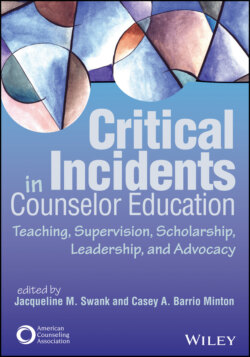Читать книгу Critical Incidents in Counselor Education - Группа авторов - Страница 31
Critical Incident Response
ОглавлениеVaibhavee R. Agaskar and Jean Georgiou
The authors considered three important factors: Mary’s ethical behavior, the role of the instructor in assessment, and students’ growth and development in the graduate program. Although Mary did not commit any serious violations of the ACA Code of Ethics (ACA, 2014), students who aspire to become professional counselors must follow ACA’s guiding principles of fidelity and professional responsibility.
Professor Madden needs to support students in completing their work and assignments. Rather than turning in an entire project at the end of the semester, it might be beneficial for students to turn in sections so instructors can give plentiful opportunities for students to revise their work before it receives a final grade (Bain, 2004). Professor Madden may also work on a rubric that specifies group members’ tasks and responsibilities along with learning outcomes for the assignment. The rubric in Table 2.1 will help group participants evaluate their contributions to the group process. Considering the intricacy of group projects, it might be beneficial for students to receive grades both individually and as a group.
The crux of this analysis is the impact of group process on student development. Per CACREP Standards (CACREP, 2016), an adviser is required at all times during the program. Professor Madden may consider working with Mary’s adviser to assist Mary in understanding her responsibilities as a graduate student. In addition to her academic and clinical skills, the program faculty need to evaluate Mary’s professional dispositions. If needed, an adviser could create a remediation plan with Mary, with periodic accountability check-ins regarding other coursework until she progresses satisfactorily. An academic adviser could also suggest students seek supplementary services (e.g., in the writing center or counseling center) to support their academic and personal growth.
As a single parent who was working full time and returning to college after some life experience, Mary was a nontraditional student. Nontraditional students may face a variety of concerns and special needs requiring different approaches and methods (Rash et al., 2008). Mentorship plays a valuable role in the optimal development of students and may be helpful when working with nontraditional students across disciplines (Mullen, 2005). ACA (2012) and CACREP (2016) have also highlighted the importance of mentorship in the counseling profession. Faculty mentorship and contact are especially valuable for helping females and minoritized students feel connected to their programs in ways that may improve the retention and graduation rates of these students (Butler et al., 2013; Le-chuga, 2011). Mary may benefit from working with faculty members who can advise or mentor her in the graduate program. Similarly, peer mentorship may be advantageous to Mary (Boswell et al., 2015). For example, membership in Chi Sigma Iota might help Mary build a strong support network with peers during the program and beyond.
Part of ensuring student success is not only providing students with necessary tools but also showing them how to use them. Some students will require different tools or more time learning how to use them than others. Through various stages of guidance, advisement, mentorship, and professional development, students like Mary can triumph in academia as well as in the counseling profession.
• • •
